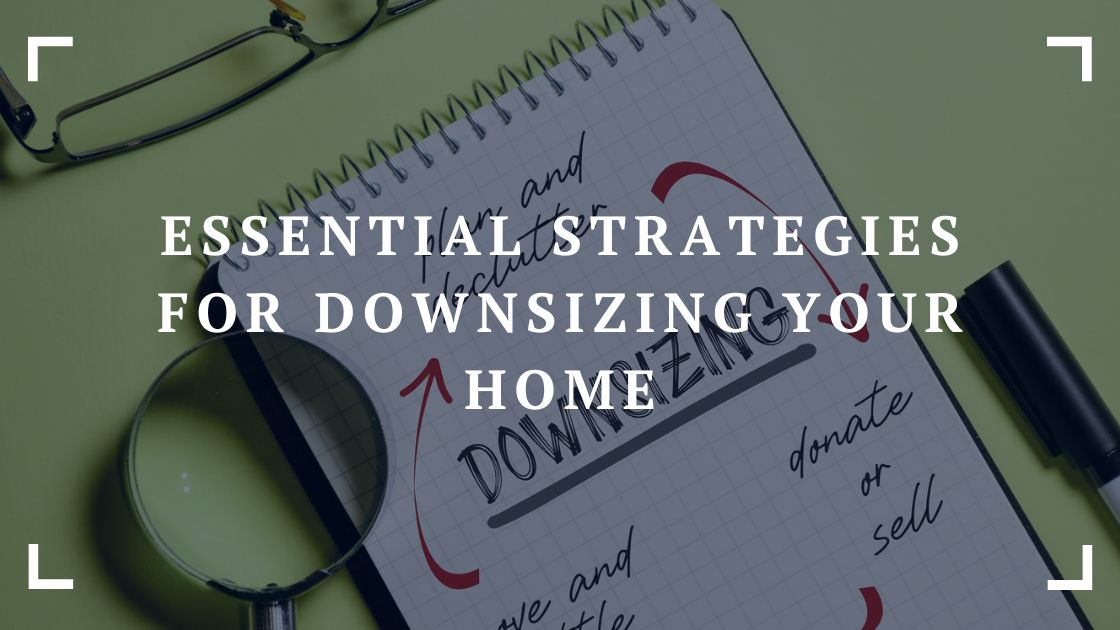People have different sentiments when it comes to their personal belongings. Some may find it easier to let go of old items to give way to new ones or to have more free space in their homes. Others may prefer to hold on to some things for longer despite being underutilized or defective because of their sentimental value.
However, there are certain situations wherein letting go of material possessions becomes inevitable. For instance, couples who become empty nesters may find clearing their children’s rooms more practical and convenient to use the space better. Meanwhile, senior adults may find it easier to manage a minimalist household with only essential items to care for.
Downsizing your home can be a liberating process, whether it’s for moving to a smaller space out of necessity, changing your lifestyle, or decluttering your life. It involves careful planning, decluttering, and rethinking how you use space. But it doesn’t have to be overwhelming.
Before you search for solutions such as ‘self storage tyler tx hwy 110‘ or professional decluttering services, here are five essential strategies to make downsizing your home smoother and more efficient.

Understanding downsizing
Downsizing refers to reducing the size of something, and in the context of personal lifestyle, it typically means moving to a smaller living space or letting go of personal belongings. This can involve selling, donating, or discarding items that are no longer needed or won’t fit in a new, smaller home. The reasons for downsizing are varied and can include financial motives, simplifying life, reducing maintenance and cleaning efforts, or preparing for a change in life circumstances such as retirement or an empty nest.
The concept of downsizing is often associated with a shift towards a more minimalist lifestyle, focusing on keeping only what is necessary or genuinely valued and letting go of excess possessions. This can lead to a more organized, less cluttered living environment and potentially lower living costs due to the smaller space. Downsizing is more than a physical act; it can also be an emotional and psychological process, as it often involves parting with items that have sentimental value or represent a part of one’s life history.
Ultimately, downsizing is a personal journey that can lead to a simpler, more focused lifestyle, allowing individuals to prioritize what is most important to them.
Downsizing one’s home can appeal to individuals and families for multiple reasons. Typically, those who find themselves needing or wanting to downsize may include:
- Retirees and seniors: Many people downsize their homes as they age, particularly upon retirement. A smaller home can mean less maintenance, lower costs, and a more manageable living space, especially for those with reduced mobility.
- Empty nesters: Once children grow up and move out, parents often live in a larger home than they need. Downsizing can provide a more suitable living situation and an opportunity to focus on lifestyle preferences or hobbies.
- People seeking a simpler lifestyle: Individuals or families looking to simplify their lives may opt for a smaller home. Downsizing can help reduce living expenses, decrease maintenance chores, and encourage a minimalist lifestyle, freeing up time and resources for travel, hobbies, or other interests.
- Financial reasons: For those looking to reduce living expenses, pay off debt, or save money, downsizing to a smaller home can significantly cut costs related to utilities, taxes, maintenance, and mortgage payments.
- Transitions to assisted living or senior communities: Seniors may downsize to move into assisted living facilities or communities designed for older adults, where they can access healthcare and social activities suited to their needs.
- Urban dwellers: Individuals moving from suburban or rural areas to a city may downsize due to the typically smaller living spaces available in urban settings. This can be driven by job opportunities, lifestyle changes, or a desire to be closer to cultural and social amenities.
- Environmental concerns: Some people downsize as part of a commitment to reducing their ecological footprint. Smaller homes can be more energy-efficient and environmentally friendly, aligning with sustainability goals.
- Life changes: Major life events such as divorce, the death of a spouse, or sudden financial changes can necessitate a move to a smaller, more affordable home.
- Digital nomads and travelers: Individuals who work remotely and travel frequently may prefer to downsize to a smaller home base or even opt for mobile living situations, such as RVs or compact mobile homes, to support their mobile lifestyle.
While these are common scenarios, downsizing is highly personal and can be influenced by a unique combination of factors.
Downsizing your home: A strategic guide
Planning a downsizing move involves thoughtful preparation and organization to ensure the process is as smooth as possible. Here’s a list of essential strategies to guide you through your downsizing journey:
1. Start with a plan
The first step in any successful downsizing effort is to start with a clear plan, which you can create by following the points below:
- Define your goals: Start by understanding why you’re downsizing. Are you moving to a smaller home to reduce living expenses, simplify your lifestyle, or because you’re transitioning to a new life stage? Clear goals will help guide your decisions throughout the downsizing process.
- Assess your new space: If you already have your new home picked out, take measurements and note the storage spaces available. Understanding the size and layout will help you decide what you can take with you and what you need to let go of.
- Create a timeline: Downsizing can take longer than expected, so creating a realistic timeline is essential. Work backward from your move date and allocate enough time for sorting through belongings, making repairs or improvements, selling or donating items, and packing.
Aside from the above, it’s important to note that downsizing involves a lot of work. So, don’t hesitate to ask for help from family and friends, or consider hiring a professional organizer, especially if you find the process overwhelming. An objective third party can make decisions about what to keep or discard easier.
2. Declutter effectively

Decluttering for downsizing involves a thoughtful process of determining what to keep, what to let go of, and how to efficiently organize your remaining belongings in a smaller space. Here are some effective strategies to help you through this process:
- Start early: Begin decluttering well ahead of schedule. This gives you ample time to sort through your items without feeling rushed. Create a schedule or checklist to keep track of your progress.
- Define your space and needs: Consider the layout and storage options you’re working with. What will fit? What won’t? Be realistic about your lifestyle and which items are essential.
- Sort items into categories: Use a system of categories like ‘Keep.’ ‘Donate,’ ‘Sell,’ and ‘Dispose’ to organize your belongings.
- Consider the ‘One Year Rule’: If you last used an item in the past year, you will likely not use it in the future.
- Focus on one area at a time: Tackle one room, closet, or category of items at a time to avoid feeling overwhelmed. Completing one area provides a sense of achievement and motivates you to continue.
- Digitize what you can: Photos, essential documents, and other paper items can take up a lot of space. Digitizing them can help save space while preserving memories.
- Let go of duplicates: You likely don’t need multiple sets of certain items. Keep the best or most necessary ones.
- Consider the emotional value: It’s often the hardest to decide on items with sentimental value. Create a special box for select keepsakes. Consider taking photos of items you want to remember but need more room to keep.
- Sell or donate what you don’t keep: Selling items can be rewarding and help offset moving costs. Online marketplaces, garage sales, and consignment shops are good options. Donating items can also provide a sense of fulfillment by helping others.
Downsizing and decluttering can be emotionally and physically demanding. Still, it also offers a chance to start fresh and create a comfortable, uncluttered living space that supports your current lifestyle and needs.
3. Utilize self-storage smartly
Self-storage is a fantastic option for those items you can’t bear to part with but won’t fit in your new space. Utilizing self-storage can be especially helpful for seasonal items, sentimental belongings, or things you plan to use in the future but need more space. Make sure to choose a storage facility that offers the right size unit for your needs and features like climate control if you’re storing sensitive items.
4. Think vertically
Make the most of every inch in your new, smaller space by thinking vertically. Use walls for shelves, hooks, and hanging storage solutions. Tall bookcases, wall-mounted desks, and over-the-door organizers can dramatically increase your storage capacity without wasting precious floor space. Remember, the goal is to create a functional, clutter-free environment where everything has its place.
5. Adopt a minimalist mindset
Lastly, embracing a minimalist mindset can make living in a smaller space more enjoyable and sustainable in the long run. Minimalism doesn’t mean you have to live without possessions; instead, it’s about making more intentional choices about what you own. Before buying new items, ask yourself if they’re necessary and where they will fit in your home. Regularly reevaluate your belongings and be willing to let go of things that no longer serve you.
Downsizing goes beyond moving to a smaller space; it’s about reevaluating what’s important in your life and making space for it. Following these steps and taking it one day at a time can make the transition smoother and more rewarding.
Conclusion
Downsizing your home is an opportunity to simplify your life and focus on what’s truly important. By starting with a clear plan, decluttering ruthlessly, using self-storage options, maximizing your use of space, and adopting a minimalist mindset, you can make the transition to a smaller home smooth and rewarding. Remember, downsizing isn’t just about reducing the space you occupy; it’s about creating a more intentional, streamlined lifestyle.


